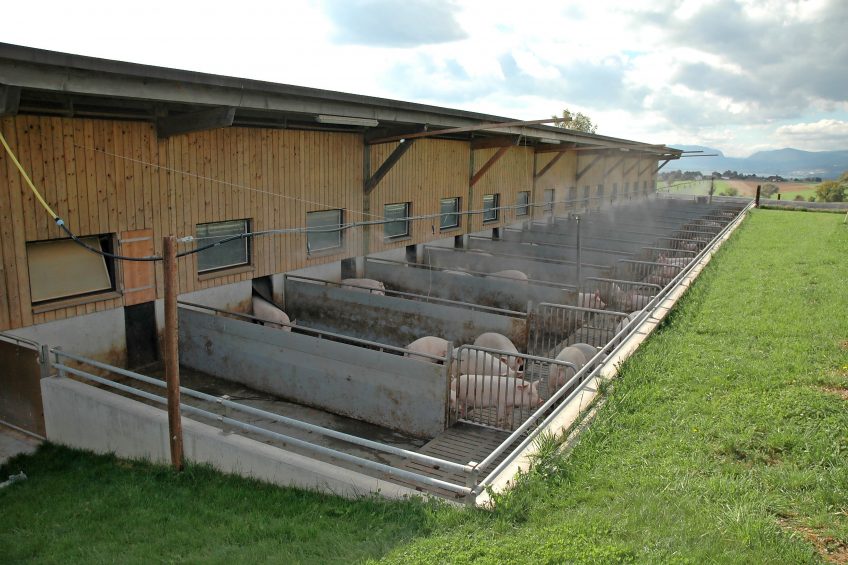Switzerland, a pig ‘island’ surrounded by the EU

Switzerland has an outstanding tradition of being an independent country. Throughout history, the country well-known for chocolate, followed its own course. Advanced standards are not only applied in their precision instruments like the famous Swiss watches, but also in the pig industry. This results in progressive animal welfare rules, high animal health status and first-class pork.
In Switzerland, pig production can be seen as a niche production. The small country produces 2.6 million slaughter pigs a year, with an average carcass weight of 89 kg. Production is done by roughly 120,000 sows, held on about 2,200 sow farms with in average 60 sows per farm.
By Swiss law, a sow farm may not exceed 250 sows. There is one exception to this upper limit, if the farm processes by-products from the food industry, for example fresh whey, it may hold up to 500 sows. The Swiss government keeps self-sufficiency on a strategic level of 97%.
Specialised insemination farms
About 15 to 20% of the piglets are born on specialised insemination farms, a system that existed in Germany until the late 1980s. After weaning, the sows from five to seven farrowing farms are transported to this insemination farm. Ten days before farrowing, the gestating sow is relocated to the farrowing farm. The sows grow the piglets until 20 kg, at which weight the piglets are off to a finisher farm.
In general, Swiss farmers receive high prices for their products, and this is needed to face the high production costs. A 20 kg piglet costs around CHF100 (€ 92). The price per kg slaughter weight is about € 3.40, which can even go to € 3.90 if the farm meets certain standards for animal welfare. Moreover, about 30% of all pork in Switzerland is sold within an animal welfare label.
In the early 1990s, the two main labels IP-Suisse and Naturafarm, owned by the two largest retailers Migros and Coop respectively, set the standards for animal welfare. Sows held under these labels never see the inside of a classic cage, except for two hours during insemination. Lots of space and organic bedding like straw is required.
Regarding sows, by now, Swiss law has sort of caught up with these demands – leaving not many differences between the legal and label requirements in sows. Also the government pays a reward for certain housing standards. About two-thirds of all pigs are held by these extra-legal welfare standards. Having said that, housing design, housing materials and labour are quite expensive.
Figure 1 – Actual development of the pig price/kg in Switzerland in the last five years. In week 13 of 2017, the pig price/kg was CHF3.80 (€ 3.49).

Far ahead on animal welfare
These high standards are the reason why Switzerland is far ahead on animal welfare. The hottest topics in other pig producing countries are already reality in the alpine country. Group housing of pregnant sows has been required by law since 2002. In addition, the typical farrowing pen is designed without any cage for the sow and this has been the case for about 30 years. On top of that, free farrowing has been required by law since July 2007 and castration is only allowed with anaesthesia since 2010, mostly using isofluran and metacam against pain and inflammation.
The retailers tested and rejected the use of intact boars or the usage of immunovaccination. Tail docking is forbidden in all piglets. Not many problems are found here, because of the organic bedding and space per pig. For finisher pigs, in the labels this can add up to 1.60 m2 per pig, including an outdoor outlet. On top, as from September 2018, every finishing pig has to have at least 0.9 m2 by law. When added up, one-finisher place costs about € 1,200 and one sow place would cost around € 12,000.
Feed in Switzerland
In line with Swiss politics, raw materials for feed are subject to high import duties. This is an important cost, since half of all grains are imported, because of the lack of farmland. In contrast with their Austrian neighbours, no on-farm mixing exists in Switzerland – except for by-products as mentioned above.
By far most of the feed is complete feed, so pelleting is the general rule. Two large feed mills, UFA and Melior take account for roughly half of the market, followed by a set of small, privately owned feed mills. Given only genetically modified organism (GMO) free soya is allowed, altogether feed prices amount to € 500/tonne.
Switzerland at a glance
The federal republic Switzerland is like an island in the heart of Europe and the EU. It has a long tradition of being a neutral country, which is why it chooses not to be part of the European Union. It has an area of 41,285 km2 on which almost 8 million people find their home; about 25% of its area is cultivated farmland. The two global cities, Zürich and Geneva are seen as the main economic centres, although the official capital city is Bern. The country is divided in 26 cantons, which have a high level of authority. Switzerland has no less than four official languages: German, French, Italian and the seldom spoken Romansh.
Advantages of isolation
Being isolated by import/export boundaries means, however, that Switzerland has a strategic advantage on the sanitary level. The country is free of Classical Swine Fever (CSF), Aujeszky’s Disease, Foot-and-Mouth Disease – as are most other European countries. Surrounded by pig countries like German, France and Italy, however, the nation also managed to be free of Porcine Reproductive and Respiratory Syndrome (PRRS), which is quite an accomplishment. Mycoplasma, atrophic rhinitis (AR) and Actinobacillus pleuropneumoniae (App) are rarely found. Even though the shortest route from Germany to Italy is through Switzerland, all pigs have to pass via Austria, as the Swiss borders are closed for living pigs and fresh semen. Vaccination against PRRS, Mycoplasma and App are not allowed.
Pig breeding issues
Major breeding organisations like PIC, Topigs or Danbred are absent in Switzerland, partly because of the relative small and protected market, partly because import of living pigs are subjected to a three-month quarantine and only frozen semen can enter the country.
Suisag is the leading breeding organisation in Switzerland. It is owned for 70% by Suisseporcs, the association of Swiss pig producers, some supply companies and various stand-alone farmers.
Sows are Swiss Large White (Edelschwein), Swiss Landrace or (by far the majority) their F1 descendant Primera. About 70% of finisher pigs are ‘Premo’, a commercial breed by Suisag, derived from the Swiss Large White and characterised by a high daily gain (+1,000 g/d) and lean meat content of around 58%. Duroc has a market share of 20% while 10% goes out to Piétrain.
This article was written with the kind help of Dr Henning Luther, Suisag and farmer Martin Scheidegger.











